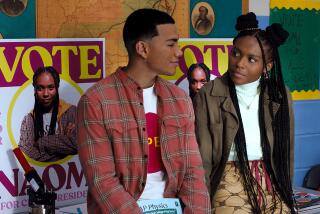TV REVIEWS : A Look at Past, Future of ‘AIDS Research’
- Share via
Human nature is perhaps HIV’s best friend, and something no scientist on Earth can combat. But human nature contains hope along with risk-taking, and the scientists hunting for a vaccine or cure for the virus may be feeling a new surge of optimism.
At least, that’s the strong impression left by the WGBH-produced “AIDS Research: The Story So Far.” Writer-producer Jon Palfreman squeezes much of the 13 years of frustrating research and scientific dead-ends into a few minutes, but the summary--along with an animated graphics sequence illustrating the molecular activity--helps explain why a cure for AIDS remains so elusive.
*
Such past “breakthroughs” as the AZT vaccine proved easily surmountable by the AIDS virus’ startling ability to mutate. Rarely has television science so lucidly visualized how a virus is like any living thing, forever searching for means to survive.
The virus’ skill at mutating makes it able to penetrate cells and take over the body’s genetic structure. Current drugs can only slow this mutation process, but sooner or later, one or more of the thousands of various strains of the disease will defeat the drug’s effect. And scientists such as Ronald Desrosiers of the New England Primate Research Center found little hope in conventional therapies.
Palfreman’s report dwells largely on the impact of Desrosiers’ very unconventional therapy, which emerged from studies with his primates deliberately infected with an injected HIV strain. The injected strain, consisting of a weakened virus in which key genes were removed, is called an attenuated vaccine.
Because the monkeys with this vaccine showed no signs of the primate form of AIDS in four years, Desrosiers argues that it may be time for human experiments. His case is further boosted by the small population of HIV-resistant patients, who appear as healthy today as the day they contracted the virus.
The National Institutes of Health’s Anthony Fauci, long accused by AIDS research activists of an overly slow and deliberate approach to finding a cure, does nothing here to change that image. Fauci wonders if biochemists and society at large would be willing to try Desrosiers’ radical test and later voices the possibility that a cure for AIDS may never be found.
*
But activist Martin Delaney argues convincingly that such a test has a willing test group, including himself, and that no durable vaccine will be discovered without some risk. Besides, biomedical ethicist Arthur Caplan reminds, the pandemic levels of AIDS-related death in Africa and now in Asia call for aggressive therapies.
When the words, “the most formidable microbe in history” come out of the mouth of narrator Will Lyman, they carry an extra ominous tone. If science history suggests anything, no “Manhattan Project” for AIDS--as ACT-UP and its allies demand--will break what amounts to a plague in the Third World. Instead, like the discovery of rubber, a breakthrough will probably happen when scientists least expect it.
* “AIDS Research: The Story So Far” airs at 9 tonight on KCET-TV Channel 28 and KPBS-TV Channel 15; 8 p.m. on KVCR-TV Channel 24.






